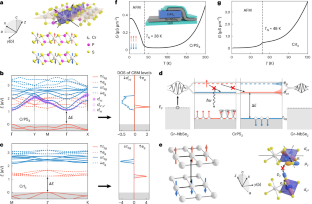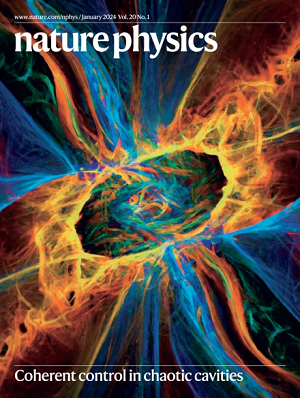Quantum tunnelling with tunable spin geometric phases in van der Waals antiferromagnets
IF 17.6
1区 物理与天体物理
Q1 PHYSICS, MULTIDISCIPLINARY
引用次数: 0
Abstract
Electron tunnelling in solids, a fundamental quantum phenomenon, lays the foundation for various modern technologies. The emergence of van der Waals magnets presents opportunities for discovering unconventional tunnelling phenomena. Here, we demonstrate quantum tunnelling with tunable spin geometric phases in a multilayer van der Waals antiferromagnet CrPS4. The spin geometric phase of electron tunnelling is controlled by magnetic-field-dependent metamagnetic phase transitions. The square lattice of a CrPS4 monolayer causes strong t2g-orbital delocalization near the conduction band minimum. This creates a one-dimensional spin system with reversed energy ordering between the t2g and eg spin channels, which prohibits both intralayer spin relaxation by means of collective magnon excitations and interlayer spin hopping between the t2g and eg spin channels. The resulting coherent electron transmission shows pronounced tunnel magnetoresistance oscillations, manifesting quantum interference of cyclic quantum evolutions of individual electron Bloch waves by means of the time-reversal symmetrical tunnelling loops. Our results suggest the appearance of Aharonov–Anandan phases that originate from the non-adiabatic generalization of the Berry’s phase. It is difficult to control the geometric phase of particles as they undergo quantum tunnelling. Now tuning of the geometric phase of electron spin is demonstrated in tunnelling in a multilayer van der Waals antiferromagnet.


范德华反铁磁体中可调谐自旋几何相的量子隧穿技术
固体中的电子隧穿是一种基本的量子现象,为各种现代技术奠定了基础。范德华磁体的出现为发现非常规隧道现象提供了机遇。在这里,我们展示了在多层范德华反铁磁体 CrPS4 中具有可调谐自旋几何相的量子隧穿现象。电子隧穿的自旋几何相是由磁场依赖的元磁相变控制的。单层 CrPS4 的方形晶格在导带最小值附近产生了强烈的 t2g 轨道脱ocalization。这就形成了一个在 t2g 和 eg 自旋通道之间具有反向能量排序的一维自旋系统,它既禁止通过集体磁子激发进行层内自旋弛豫,也禁止在 t2g 和 eg 自旋通道之间进行层间自旋跳跃。由此产生的相干电子传输显示出明显的隧道磁阻振荡,通过时间反转对称隧道环路表现出单个电子布洛赫波循环量子演化的量子干涉。我们的研究结果表明,阿哈诺夫-安南丹相的出现源于贝里相的非绝热广义化。
本文章由计算机程序翻译,如有差异,请以英文原文为准。
求助全文
约1分钟内获得全文
求助全文
来源期刊

Nature Physics
物理-物理:综合
CiteScore
30.40
自引率
2.00%
发文量
349
审稿时长
4-8 weeks
期刊介绍:
Nature Physics is dedicated to publishing top-tier original research in physics with a fair and rigorous review process. It provides high visibility and access to a broad readership, maintaining high standards in copy editing and production, ensuring rapid publication, and maintaining independence from academic societies and other vested interests.
The journal presents two main research paper formats: Letters and Articles. Alongside primary research, Nature Physics serves as a central source for valuable information within the physics community through Review Articles, News & Views, Research Highlights covering crucial developments across the physics literature, Commentaries, Book Reviews, and Correspondence.
 求助内容:
求助内容: 应助结果提醒方式:
应助结果提醒方式:


